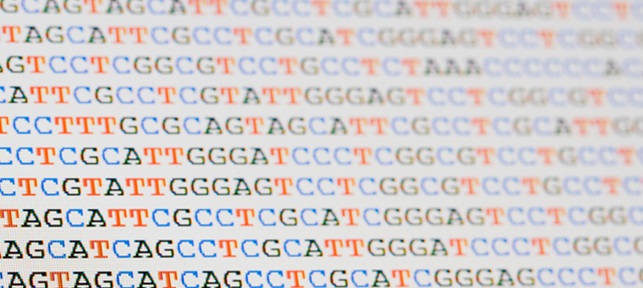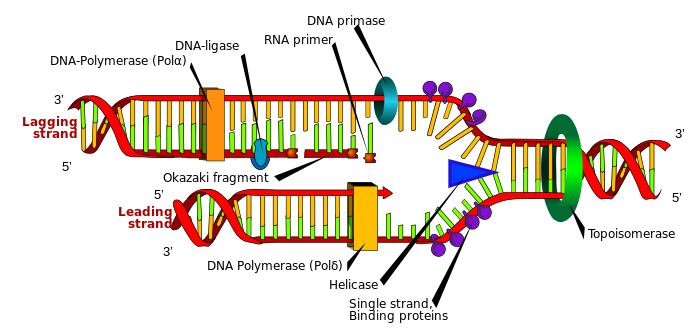Lil' Science Dictionary. DNA, RNA, Proteins, and related Processes. Part 2 - DNA replication and transcription
education·@jplaughing·
0.000 HBDLil' Science Dictionary. DNA, RNA, Proteins, and related Processes. Part 2 - DNA replication and transcription
In part 1 we learned the absolute basics about the nature of [DNA](https://steemit.com/education/@jplaughing/lil-science-dictionary-dna-rna-proteins-and-related-processes-part-1-dna) Since we know DNA is a biological blueprint for making an organism, it's only logical we should explore mechanisms which govern the blueprint aspect of the DNA function. For a single cell to operate, stay alive, and ultimately, divide into two, the genetic material inside of it, with help of cellular machinery, need to perform two major tasks. One being, nucleic acid need to be Replicated, which technically means, every letter in the sequence of DNA have to be rewritten in the same order onto a new chain of nucleic acid. The process of replication need to be near perfect, and every imperfection in the copying, may result in a mutation. Another major task for cellular machinery in tandem with DNA, is to Transcribe genes into RNA molecules. The RNA itself is a talk for another time. However, long story short, it is an important molecule. Crucial for regulation of processes within the cell, and to build all cellular components.  So how does `Replication` of DNA work? Every step of the way, special proteins perform various tasks on a DNA chain. As we learned, DNA forms double stranded, helically twisted chains. To allow the process of replication, first, the double helix need to be untwisted. there are specialised enzymes which will locally straighten the chain. Regions on DNA sequence where replication may be iniciated, we call them Origin. Origin sites have higher density of A-T pairs. That is becaues, A-T pairs have only Two hydrogen bonds connecting them, as opposed to C-G pairs, which have Three hydrogen bonds. Therefore, they are easier to break. Once the twist is gone, That's when proteins responsible for breaking hydrogen bonds in base pairs can act upon the DNA. Different factors are being recruited to, now fully exposed base pairs Time for replication. DNA polimerase, an unique enzyme which have an ability to synthesize nucleic acid chains from free nucleotides, forms a complex with proteins initiators, and is ready to go. After the process starts, DNA polimerase create a new chain complementary to the one acting as a template. The run don't stop until the replication complex meets another complex, or in case of eukaryotic cells [i.e. human cells] the end of the chromosome. However, DNA polimerase can only synthesize a new chain in one direction. The direction is often called 5' to 3', it means that the 5' carbon of sugar deoxyribose is in front of the replication complex, and 3' carbon is behind it. Because of that, during the replication run, there's always a Leading Strand, and Lagging Strand being synthesized. Leading strand goes forward unrestricted, as the double helix is being unwinded, and base pairs broken right ahead of it. However, the Lagging strand don't have so much liberty. Since the DNA duplex is being separated only in one direction, Lagging strand can only synthesize in small portions at a time. After the deed is done, and replication terminates, both DNA duplexes can separate from eachother.  DNA `Transcription` is an ongoing process which hardly ever stop. Unlike replication, which is required only when the cell is about to divide, transcription is vital to cell maintenance and growth. There are genes which code for almost any cellular component. >One gene equals one protein is a popular saying. Reality is not as simple, but there's no need to complicate things. We will assume that it is indeed a valid statement. Human genome have an estimate of 20.000 to 25.000 protein coding genes. However, proteins are not the only product of DNA transcription. When transcribed, DNA sequence is rewritten as a complementary chain of RNA. RNA is then processed, depending on it's function. Before DNA sequence can be written into brand new RNA chain, a bunch of proteins called transcription factors find a promoter. Promoter is a special sequence of DNA which can efficiently recruit said factors. Promoter most oftenly can be found before the gene sequence. Once promoter is recognized, RNA polimerase also joins the party, and sits on the DNA chain. Transcription starts when all elements are in their place, but the RNA polimerase need to `escape` the promoter firstly. Before that happens, it oftenly generates a number of short RNA seqences. Such process is called abortive initiation. Once the polimerase escapes, the real run of transcription starts. The template for RNA molecule is read from 3' to 5', which means, the RNA chain is synthesized 5' to 3'. After the desired DNA fragment is transcribed to RNA, there's an event of termination. Depending on the function of given RNA, termination process may occur with slight differences. The mRNA termination we learned the most about. It usually involves, breaking off the RNA from the DNA template, and addition of long tail of repeating motifs. For example, poli-A tail protects eukaryotic mRNA from being digested within the cell and increase their stability and half-life.  `To be Continued in: Part 3, RNA.` >This post is just one in a serie called Lil' #Science #Dictionary. The purpose of the serie is educational in nature, created to explain in simple terms certain scientific concepts. If you like what you've read, and you want to see more come your way. Make sure to Comment, Follow, Like, and/or Resteem. >`Help Extend the Dictionary by suggesting topics you'd like to see explored.`
👍 jplaughing, rmsbodybuilding, unadvised, civic, likeboss, klinovslava2000, bkvas, labby, evgenymih2285, yanatit, qwert4, spiritshere, nikolle, a1010011010101, stimmy, greatbritain, kakakaka, crazybanana, brickblow, rusmil56, whoamiandy123, t-bone, penny-wise, jenydim, indikator, antonkoval, darkpart, lenkapenka, taganrog, eblog, whatare, avalanchemusic, dionsy, danez66, legenda, zoraivanov92, artemnezlobin, vladser58, mee6, appreciator, lkazakova281, yukimom,